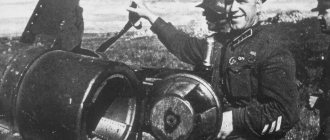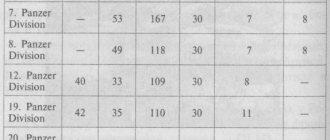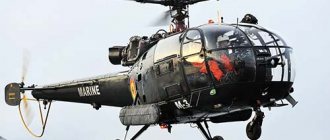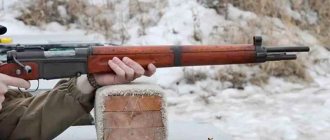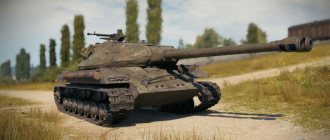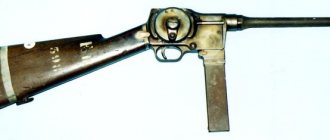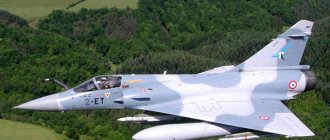Back on February 17, 1940, A. Hitler was presented with a plan for an attack on France. After the Fuhrer made his own adjustments to it, this document received approval from the German military leadership. Under the approved plan, called Painful Strike, the attack on France was carried out by three groups of German armies, during which powerful tank columns would break through the forested Ardennes where the Allies least expected them.
French infantryman. Armament, uniform and ammunition of the 1940 model. Reconstruction
After the evacuation of the Allied forces from Dunkirk, the French command was left with 60 divisions, of which only three were armored. Opposed to them were 89 German divisions, 15 of which were tank and motorized. Luftwaffe units had at their disposal about 2.5 thousand aircraft, most of which were attack aircraft. The French could hardly count on 980 aircraft of various modifications.
Line to appease
This is understandable: if the French emerged victorious from the first conflict, despite huge losses, the second brought the country little honor and a lot of shame. In June 1940, France bowed its head to the might of the Wehrmacht, recognizing its complete defeat.
To briefly outline France's foreign policy between the two wars, it consisted of maintaining the existing order of things and preventing a new conflict that would require significant sacrifices from the French. From these aspirations grew the policy of “appeasement,” with the help of which Parisian leaders tried to build relations with Nazi Germany, which was gaining strength. The culmination of this line was the negotiations in Munich in 1938, at which England and France agreed to the transfer of the Sudetenland to Czechoslovakia by Germany. Taking advantage of the fact that France actually gave Hitler a free hand, even Polish troops captured a piece of Czechoslovakia.
By the spring of 1939, Hitler had completely liquidated Czechoslovakia, turning it into the Protectorate of Bohemia and Moravia. It became clear that it would not be possible to reach an agreement with the Third Reich. However, France and Great Britain continued to combine, hoping that Hitler would go on another military campaign not to the west, but to the east, and attack the Soviet Union. The non-aggression pact signed in August 1939 between Moscow and Berlin confused the plans of the Western powers. The Soviet Union received time to rearm its army.
A pact, like everyone else’s in Europe. Did the USSR have the right to negotiate with Hitler? More details
Promises and reality
On September 1, 1939, Germany attacked Poland. France and Great Britain, which gave Warsaw military guarantees, declared war on the Third Reich on September 3.
In 1939, France had the third largest land army in the world by the number of tanks and aircraft after the Red Army and the Wehrmacht, as well as the fourth largest navy in the world after the British, American and Japanese. The French had a significant advantage over the Germans on the Western Front in terms of forces and resources. However, in the first days of the war, the French army was virtually inactive. Subsequently, historians will explain this by difficulties with mobilization. But even then they called it the “Strange War”, understanding that France did not want to fight, even despite its allied obligations. There was an opinion that Hitler would get stuck in the Polish direction or, having passed through Poland, would move towards Moscow. The military and political elite of Paris also understood that the army, despite its large size, was in dire need of reform, and the citizens themselves were not ready to fight “at any cost.”
Only by September 13, 1939, the French managed to relatively easily occupy two forward sections of the German defensive “Siegfried Line”: the Warndt section west of Saarbrücken and the protrusion of the border between Saarbrücken and the Palatinate Forest.
A full-scale offensive capable of forcing the Germans to begin transferring forces from Poland never followed. Messages arrived in Warsaw: the operation was postponed due to the difficulties of its preparation. And on September 17, the offensive was completely canceled. The situation of the Poles who did not receive help became hopeless.
In October 1939, the Germans launched an offensive, regaining all the territories previously captured by the French. The French army, without engaging in serious clashes, withdrew behind its defensive Maginot Line.
"Strange War"
Over the next few months, the so-called “Strange War” took place: the parties did nothing, maintaining their existing positions.
The passive defense tactics of the Anglo-French forces assumed that the Wehrmacht would waste time and energy in fruitless attempts to overcome the practically impregnable Maginot Line. Ultimately, a protracted conflict will lead to Germany becoming overextended, and victory will go to the Allies with minimal losses.
Similar constructions were made based on the experience of the First World War. However, the German command also learned the lessons of the past.
The Maginot Line's fortifications included multi-level underground forts with living quarters, ventilation plants and elevators, electrical and telephone exchanges, hospitals and narrow-gauge railways. The gun casemates were protected by 4-meter concrete walls. The defense of the line was provided by 300,000 troops.
But the Germans relied on the widespread use of tank formations and bomber aircraft in cooperation with mobile reserves, and their main trump card was deep breakthroughs with the subsequent encirclement of the main enemy forces. It was the organization of troops and their actions that was the main detail of the “superweapon” of the Verkhmat, even more important than the tanks themselves. And at that moment no one in the world could oppose anything to this.
General Shaposhnikov's forecast. In 1938, the USSR was waiting for a strike from Germany and Poland Read more
Rapid advance
On June 5, Army Group B launched an offensive. Its striking force, the Hoth tank corps, immediately wedged itself deeply into the enemy’s defenses. The French were unable to resist the tank attack, and the 7th Panzer Division of General Z. Rommel began to rapidly advance towards the Seine. By June 8, Rommel was in Rouen and, taking advantage of the enemy’s complete confusion, turned to the sea and cut off the 51st British Division and significant French forces at Saint-Valery. Only to the east did French troops manage to stop the advance of Kleist's tank group, which tried in vain to break out from the bridgeheads at Amiens and Peronne.
The troops of Army Group A went on the offensive on June 9. The first task was to seize bridgeheads on the southern bank of the Aisne. Having created a bridgehead near the city of Rethel, they built a bridge on the night of June 9-10 and crossed the river by morning. Here, Wehrmacht units met powerful French resistance, making numerous villages and groves difficult to overcome. The Germans assigned the liquidation of these pockets of resistance to motorized rifle regiments, while tank units passed by, trying to advance as far as possible to the south. On the afternoon of June 10, French reserves, including a newly formed armored division, counterattacked Guderian's tanks but were defeated.
The power of the Maginot Line
As the events of the “French campaign” showed, all previously made statements that the Maginot Line was impregnable and its fortifications could withstand any attack turned out to be nothing more than a bluff. The main role in the breakthrough was played by German aviation and artillery, which widely used smoke shells. It was soon discovered that many of the French pillboxes could not withstand direct hits from shells and bombs, and a large number of structures were not designed for all-round defense and could easily be attacked from the rear and flank with grenades and flamethrowers. As a result, the Maginot Line's defenses were breached within a few hours by a conventional German infantry offensive with little or no tank support.
Soldiers cross a bridge into a French underground fortress on the Maginot Line. May 1940
Strike through the Ardennes
On May 10, 1940, the implementation of the German offensive plan “Gelb” began, the targets of which were France, Belgium and the Netherlands.
According to the plan, German Army Group B was supposed to pin down enemy forces, capture the Netherlands and Belgium, quickly break through border fortifications and prevent the advance of the Anglo-French army in Belgium.
Army Group A, in turn, was supposed to make a breakthrough through the Ardennes and reach the rear of the main Allied forces located north of the breakthrough.
The German plan seemed extremely risky and technically complex, but it was 100 percent successful. It took the Wehrmacht just five days to capture Holland. In Belgium, already in the first days of the war, the Nazis captured key points, which allowed them to successfully develop a further offensive.
By May 14, seven German tank divisions had crossed the Meuse River. The reserve French divisions found themselves in their zone of action between Sedan and Namur, which were defeated in a matter of hours.
By May 20, German units reached Amiens and Abbeville, and the next day they captured Saint-Paul and Montreuil. North-west of Abbeville, the first German unit - a battalion of the 2nd Panzer Division - reached the sea.
The British and French units, pressed to the sea, were no longer concerned with the issue of victory, but exclusively with evacuation. The British managed to escape from Dunkirk, which is now presented by Western historians as a great military success.
Wehrmacht plans
The German High Command's plan for the last stage of the "French campaign", called "Rot", called for three strikes. Army Group B (commanded by Field Marshal F. von Bock), with six tank divisions, breaks through the enemy front between the Oise and the sea and advances southward with the task of reaching the Seine in the Rouen region. A few days later, Army Group A (commanded by Field Marshal G. von Rundstedt), with four tank divisions, begins an offensive on both sides of the Rethel and breaks deep into France, with the final goal being the Langres plateau. After the offensive of both groups unfolds, Army Group C (commanded by Field Marshal W. von Leeb) attacks the Maginot Line and seeks to break through it between the city of Metz and the Rhine River.
Main tanks of France
At the outbreak of World War II, the S35 was one of the most modern and combat-ready tanks of the French army, even though it was developed by Somua back in 1934. Production of the S35 began in 1938 and continued until the defeat of France in June 1940 During this period, about 427 tanks of this type were produced, of which about 297 units, after the defeat of France, entered service with the Wehrmacht and were used almost until the very end of the war.
French medium tank S35 (Somua S35)
"We are defeated, we lost the battle"
But the main part of the French had nowhere to run. A military catastrophe was approaching them in full swing.
By June 4, the Nazis occupied Northern France and Flanders. The demoralized French units tried to resist, but it already resembled agony.
Question answer
Winston Churchill.
Special signs In fact, the breakdown occurred already in the first days of the German offensive. On May 15, 1940, French Prime Minister Paul Reynaud telephoned Winston Churchill , declaring: "We have been defeated... They are rushing into the breach with tanks and armored vehicles."
Churchill tried to calm Reynaud, but he repeated as usual: “No, we are defeated, we lost the battle.” And, as time showed, he was right. The new phase of the offensive, launched by the Germans on June 5, finally collapsed the French defenses. No attempts were even made to defend Paris: the French government fled the capital to Bordeaux. On May 14, Nazi units entered the main French city without a fight.
The eternal Russian question “What to do?” stood before French politicians. The number of those who advocated continued resistance turned out to be less than the number of supporters of capitulation. Prime Minister Reynaud refused to negotiate peace and resigned on June 16. , Marshal Henri Philippe Pétain, was appointed as the new head .
Fall of the capital
After Kleist's failure, his tank group was transferred to the Laon area, where it immediately broke through the French defenses and, rapidly moving forward, reached the Marne in the Chateau-Thierry area on June 11. The next day, Guderian's tanks reached the Marne in the Chalons area. After this, eight German armored divisions rushed south on either side of Reims. On June 14, the French capital was taken, although, as German generals noted, this was only a small episode of the great offensive, since Paris itself had no strategic significance. At this time, Hoth's Panzer Corps was already operating in Normandy and Brittany, Kleist's Panzer Group was heading towards the Langres plateau and the Rhone Valley, and Guderian's Panzer Group turned east to Lorraine to attack the Maginot Line from the rear. On June 14, the 1st Army, part of Army Group C, broke through the Maginot Line south of Saarbrücken.
Residents of Paris from the people's militia are trying to resist the advance of German troops
On July 14, 1940, the German army entered Paris. The very next day, the remaining Parisians in the city were awakened by a loud speech coming from loudspeakers in French with a strong German accent about establishing a curfew and moving the clocks forward an hour. From now on, the French capital began to live according to Nazi laws and Berlin time. By the way, there is a story according to which A. Hitler was unable to climb the Eiffel Tower, since the elevators were disabled by patriotic French. As a result, all he could do was take pictures against the backdrop of the tower.
After the breakthrough of the “pride and hope of France,” the entire French defense collapsed, and the pace of the German offensive was limited only by the lag of infantry formations. On June 16, Kleist's tanks entered Dijon, and on June 17, Guderian's advance troops reached the Swiss border at Pontarlier. The encirclement of the French armies in Alsace and Lorraine was completed, and on June 24 they capitulated. A report from the Fuhrer's headquarters reported the capture of 22 thousand prisoners, including the corps commander and three division commanders, as well as twelve artillery divisions and a large amount of property and equipment.
Nazi parade at the Arc de Triomphe in Paris. July 1940
Full revenge
A couple of years will pass, and the French will call yesterday’s hero nothing more than Putain, which means “whore.” So his compatriots will appreciate his tender friendship with Hitler.
But in June 1940, Pétain made piercing speeches, the meaning of which was that France must endure the shame of defeat and move on.
Hitler took care of the shame. The Fuhrer chose the Compiègne Forest, where Germany surrendered in 1918, as the place for signing the surrender. Moreover, the same railway carriage of Marshal Foch in which the documents were signed 22 years earlier was delivered from the French museum.
The signing of the Compiegne Armistice took place on June 22, 1940. According to the agreement, 60 percent of the country's territory, including Paris and the entire Atlantic coast, became the occupation zone of Germany. The French army had to disarm and hand over heavy weapons to the German troops. It was envisaged to maintain minimal formations to maintain order, the number of which was to be determined by Germany and Italy. The French navy was to be demobilized and placed in ports under the supervision of the occupying forces. France was also responsible for maintaining German troops on its territory. France handed over all German prisoners of war to the Reich, while French soldiers were to remain in prison camps until the end of hostilities in Western Europe. In addition, France undertook to extradite to the Reich German citizens located on its territory, whom the German command would indicate.
At this moment, Germany simply adored its Fuhrer. Hitler, as promised, took revenge for the humiliation of 1918. France was brought to its knees in just a few weeks.
Marshal Henri Philippe Pétain greets Adolf Hitler at Montoir-sur-le-Loire on October 24, 1940. Photo: ru.wikipedia.org
Red plan. How France fell
Adolf Hitler and his entourage pose in front of the Eiffel Tower in Paris. On the left is Albert Speer, the future Reich Minister of Defense Industry and Armament, on the right is sculptor Arno Breker. June 23, 1940
80 years ago, on June 14, 1940, German troops entered Paris without a fight. As a result of the successful offensive of the Wehrmacht, the main forces of the French army were defeated, fled or surrendered.
Operation Roth (Red Plan)
After the end of the fighting in the Dunkirk area, the German High Command began the second stage of the Battle of France.
Directive of the Wehrmacht High Command (OKW) No. 13 of May 23, 1940 determined the plan and main stages of the operation. On May 31, the Supreme Command of the Ground Forces (OKH) sent the Operation Roth plan to the troops. The Germans planned to use a swift offensive to break the remaining enemy forces in France, break through the front hastily created by the French south of the Somme and Aisne rivers, and with a quick breakthrough into the depths, prevent them from retreating into the depths and create a new line of defense. At the first stage of the operation, the right flank of the German army advanced from the coast to the Oise; on the second, the main forces struck between Paris and the Ardennes (an area in the north-east of France near its border with Belgium, characterized by high hills and dense forest) to the southeast, with the aim of defeating the French group in the triangle of Paris, Metz and Belfort, and on the Maginot Line. The third stage is auxiliary operations with the aim of capturing the Maginot Line.
The Germans regrouped their troops. Army Group B under the command of Bock, consisting of the 4th, 6th and 9th armies (48 divisions, including 6 tank and 4 motorized, 2 motorized brigades) took positions from the coast along the Somme, the Oise-Aisne canal to the river Ena. Bok's armies were supposed to make a breakthrough to the southwest from the Somme line and take Le Havre and Rouen. With the left flank, reach the area of Soissons and Compiegne, ensuring the actions of the main forces. Movable joints were to play an important role. Hoth's 15th Panzer Corps from the Abbeville area was supposed to reach the mouth of the Seine. Kleist's Panzer Group (16th Panzer and 14th Motorized Corps) was to attack east of Paris and seize bridgeheads on the Marne.
Army Group A under the command of Rundstedt, consisting of the 2nd, 12th and 16th armies (45 divisions, including 4 tank and 2 motorized) was located on the river. Aisne and further east to Luxembourg. The Germans were supposed to attack in the Reims direction, go to Bar-le-Duc, Saint-Dizier. To strengthen the attacking capabilities of Rundstedt's troops, Guderian's tank group (39th and 41st tank corps) was formed. German mobile units were supposed to go to the rear of the Maginot Line.
Army Group C under Leeb, consisting of the 1st and 7th Armies (20 infantry and 4 fortress divisions), occupied positions on the Siegfried Line and along the Rhine in readiness to capture the French fortified line. The 18th Army (4 divisions) was left in the Dunkirk area, providing coastal defense. At the same time, the 18th Army served as a reserve; it was planned to bring it into battle during the development of the offensive. Also, 19 infantry divisions remained in the reserve of the main command.
French defense
After crushing defeats in Belgium and Flanders, the French were stunned, demoralized and greatly weakened.
There were 71 divisions left under Weygand's command. The relaxation of France during the “Phantom War” had its effect. The French military-political leadership did not form strategic reserves in case of failures and did not carry out a total mobilization of the country, population and economy. At the same time, mostly second-rate divisions remained; the best fell into a trap in Belgium and Northern France and were defeated. Many of the remaining units were weakened in battle and had a large shortage of personnel, weapons and equipment. The soldiers lost heart. Four tank divisions had 50-80 vehicles each. From the troops that were able to evacuate from Dunkirk, reduced divisions were formed. On a 400-kilometer front, from the mouth of the Somme to the Maginot Line, the French fielded two army groups (49 divisions in total). General Besson's 3rd Army Group, consisting of the 10th, 7th and 6th Armies, occupied positions from the coast to Neuchâtel. The army group included two British divisions under General Brooke: the 51st Scots, transferred from the Maginot Line, and the 1st Armored Division, arrived from England. The position on the Somme was weak. Allied attempts to eliminate enemy bridgeheads in the area of Abbeville, Amiens and Peronne were unsuccessful.
General Huntziger's 4th Army Group, consisting of the 4th and 2nd Armies, occupied the defense from Neuchâtel to the Maginot Line. General Pretel's 2nd Army Group, consisting of the 3rd, 5th and 8th armies, defended the Maginot Line. Only 17 divisions remained in the 2nd Army Group. Despite the losses, the French still had a large air force fleet. However, the command was unable to organize and use all the aircraft in battle. In particular, a significant aviation group remained in North Africa. The British also did not begin to transfer aircraft to France, apparently assuming the imminent collapse of their ally and the need to defend the British Isles from the air.
A French 25-mm Hotchkiss model 1934 anti-tank gun abandoned at a defensive position on the street of Rouen
German soldiers sitting on a French Renault FT-31 tank look at a destroyed and burning building in captured Rouen
German soldiers near a captured French 25-mm anti-tank gun model 1934 on the Seine embankment in Rouen
Course for surrender
On May 25, French commander-in-chief Weygand outlined a defense plan at a meeting of the military committee.
It was planned to meet the enemy on the borders of the Somme and Aisne, covering the capital and the central part of the country. The command gave instructions to create defensive lines, strongholds in which the troops were to hold out even in the event of encirclement. That is, the French plan was a continuation of the old one: a continuous front line, stubborn and tough defense. No ideas or decisive actions were proposed if the enemy breaks through the defense line. True, the stubborn defense of the army made sense if at the same time total mobilization began in the rear. The government and military will call on the people to defend the country and carry out major mobilization events. France, even in the conditions of the disaster that occurred, had more human and material resources than the Third Reich. If the French leadership had been able to prolong the war, Germany would have had a bad time. In particular, the occupation of all of France would require enormous efforts from the Reich, the presence of a huge contingent of troops to control hostile territory. However, French politicians and the military did not want total war and mobilization, a life-and-death confrontation. When large cities become a battlefield, they tie up the enemy's forces, but lead to numerous casualties and material losses.
Weygand's plan did not provide for the mobilization of the people to fight the enemy. There was no action plan in case the government left the metropolis for the colonies to continue the struggle. And France had a huge colonial empire with large resources, a fleet that excluded the possibility of a quick victory for Germany if the war continued. And prolonging the war put an end to all of Hitler’s plans, ultimately leading to an internal crisis and defeat. France had everything to continue the war. Human and material resources of the colonies. Representatives of the civil and military administration in the colonies in North Africa, the Levant (Syria and Lebanon), French Equatorial and West Africa reported to the government about the possibility of continuing the struggle. There were 10 divisions in North Africa alone; they could become the core of a new army. The presence of a large fleet made it possible to transport part of the troops, 500 thousand reservists and weapons from the metropolis to North Africa. There was a gold reserve exported from the French Bank to the USA, Canada and Martinique. Gold could be used to pay for weapons, ammunition and ammunition. Contracts have already been concluded for the supply of weapons from the United States. There was a strong ally, Britain, with a world colonial empire.
However, the French government and generals did not prepare plans on the prospects of fighting Germany in a timely manner, and Weygand rejected all proposals to continue the war outside the territory of the metropolis. Weygand himself did not believe in the possibility of long-term defense on the Somme and Aisne, and thought about capitulation. “But since he did not want to take responsibility for it, his actions amounted to inducing the government to capitulate,” General de Gaulle noted in his memoirs. Weygand and Marshal Pétain (a member of Reynaud's government) began to pursue a policy of surrender. They gained significant weight in the government. True, General de Gaulle, an ardent supporter of the fight to the end, was appointed to the government to replace the Deputy Minister of Defense. But he had recently received the rank of brigadier general and did not have serious influence in the French military-political elite.
French tank Char B1-bis No. 518 "Alger", abandoned near the town of La Bouie, southwest of Rouen
A column of refugees leaves a city in France
German Junkers Ju-87 bombers from StG 77 shortly after takeoff from an airfield in France
Collapse of the Somme defense
On the morning of June 5, 1940, German aircraft launched a series of powerful attacks on enemy defenses.
Then the troops of Army Group B launched a general offensive. Hoth's tanks attacked from the bridgehead at Abbeville, Kleist's group operated from the bridgehead at Amiens and Perron. Hoth's divisions advanced 10 km on the first day and on June 6 broke the defenses of Altmeyer's 10th French Army. The Nazis, having repelled the counterattacks of the British tank division, cut through the French army. The left flank was blocked by the sea, the right wing of the 10th Army retreated to the Seine. On June 8, German tanks were on the approaches to Rouen. Pressed to the sea, the Anglo-French troops capitulated a few days later. Kleist's troops were unable to immediately break the resistance of General Frere's 7th French Army. The French stubbornly fought back. However, the breakthrough of Hoth's tanks in the Rouen direction eased the position of the 6th German Army of Reichenau. French resistance weakened and the Nazis reached Compiegne. The troops of the 9th German Army crossed the Aisne at Soissons and pushed back the left wing of the 6th French Army of Touchon. As a result, under enemy pressure, the French defense on the Somme collapsed. The French command hastily began to create a new line of defense from the mouth of the Seine to Pontoise on the river. Oise, then through Senlis to the border of the river. Urk. The Paris Army, created on the basis of the Paris garrison and some units of the 7th and 10th armies, hastily advanced to the north-west of the capital.
On June 9, Army Group A went on the offensive. On the very first day, the Germans crossed the Aisne and created a bridgehead in the Rethel area. Guderian's tanks were thrown into battle. The German mobile formation entered the operational space and rushed south, bypassing the Maginot Line. The French tried to launch a counterattack with reserve divisions, but the Germans easily parried and continued the offensive.
German ZSU Sd.Kfz.10/4 drives along the street of a village in the Marne department
German soldiers pose on a damaged French AMR-33 reconnaissance tank
Captured French cavalrymen and German soldiers in a village in eastern France
German Ju-87 dive bombers in flight over France
Germans in Paris
On June 10, Italy entered the war against France (As the Duce tried to capture the southern part of France).
However, despite the large numerical superiority over the French Alpine Army, the Italian troops were unable to create a serious threat to the enemy. On the same day, the French government fled from Paris to Tours, then to Bordeaux, essentially losing control over the country. On June 11, the Supreme Council of the Allies took place in Briard. The British understood that the French were inclined to capitulate. Churchill tried to prolong the resistance of the French army. He promised to land additional forces on the mainland, supported the French hopes for help from the United States, and spoke about the possibility of developing guerrilla warfare. However, he refused to increase the number of British aircraft that participated in the Battle of France. Weygand in his report outlined a hopeless military-strategic situation. He reported the loss of control, the lack of reserves, and the impossibility of continuing the fight if the new line of defense collapsed.
On June 12–13, a meeting of the French government was held in Cange near Tours. The main issue was the possibility of concluding a truce with Hitler. Weygand openly demanded capitulation. He stated that continuing the war would lead the country to mass unrest and revolution (the ghost of the Paris Commune). The commander-in-chief lied that the communists had already started an uprising in Paris. "The Lion of Verdun" Pétain also argued for the need for surrender. At the same time, he demanded that the government remain in France. The defeatists did not want some members of the government and parliament to flee to the colonies, where they could create a new center of resistance.
Meanwhile, the front collapsed. The French were unable to organize a new strong line of defense. On June 12, the Nazis crossed the Seine. In the east, south of the river line. The Marne Germans reached Montmirail. Guderian's tanks rushed uncontrollably to the south. The organized resistance of the French army was broken. With the consent of the government, Weygand declared the capital an open city and surrendered without a fight. On the morning of June 14, the Nazis entered Paris. The huge city was almost empty, most of the population had fled. Millions of French people flocked to southern France.
To be continued…
German soldiers on the Place de la Concorde in Paris
German artillerymen on the Sd.Kfz half-track tractor. 8, towing a 150mm heavy field howitzer sFH18, drives through the Place de la Concorde in Paris
Column of French prisoners at the Palace of Versailles in Paris
German machine gunner against the backdrop of the Eiffel Tower
Aliens at the victory celebration
The so-called Vichy France of Pétain, which maintained formal independence, in fact became a satellite of the Third Reich.
The crushing defeat of the French was an unpleasant surprise for the Soviet Union. By concluding a non-aggression pact with Germany, Moscow hoped that the Third Reich would be bound by the Western Front for a long time. And this will make it possible to build an army according to a new model, taking into account how the Germans fought in Poland and France. It was clear to everyone that Germany would attack sooner or later. As well as the fact that it is unlikely that it will be possible to completely rebuild and rearm the Red Army in such a time frame. And the military threat to the USSR again rose to its full extent.
The attack on the Soviet Union will take place on June 22, 1941, exactly one year after the surrender of France. This time, the Nazis’ calculations for blitzkrieg would not come true, and their hitherto impeccable military machine would be destroyed.
In 1944, France will accept liberation from the hands of others. And although the French would be among the victors in May 1945, for them the history of this war is not a celebration with tears in their eyes, but a triumph with a sharp aftertaste of shame.
